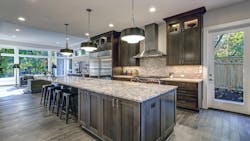10 Kitchen Design Mistakes to Avoid
As one of the most high-traffic areas of the home, a kitchen’s functionality is one of the most important parts of its design. That’s according to home remodeling and design platform Houzz, which suggests home building and design professionals consider the layout of a kitchen above finishes, fixtures, and other aesthetic features of the kitchen.
To help pros navigate their next kitchen project, Houzz asked design experts to reveal the 10 most common layout errors that they encounter and how to avoid them. The list includes: not taking workflow into consideration; not planning a space for smaller, commonly used appliances like coffee machines, microwaves, and toaster ovens; poorly planned lighting placement; not making use of vertical wall space; and wasting kitchen island space, among several other design mistakes.
Failing to allow enough circulation space can make a kitchen feel cramped and restrict the number of people who can comfortably use the space at the same time, says Jenefer Gordon, principal at interior design firm Eat Bathe Live. “It causes even more issues when your kitchen doubles as a thoroughfare. A lack of space can also make it difficult to open appliances such as the fridge and dishwasher,” she says.
Solution: To provide adequate circulation, try to have about 4 feet of space between kitchen countertops, Gordon says. Allow a little more room if there is a thoroughfare leading through the kitchen. “In a small kitchen, [39 inches] would be the minimum amount of space between countertops, but aim for more if you can,” she says.
